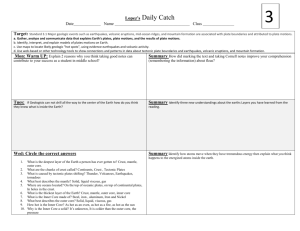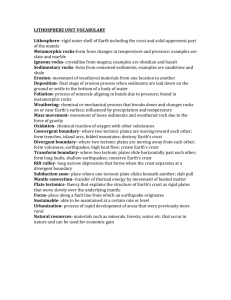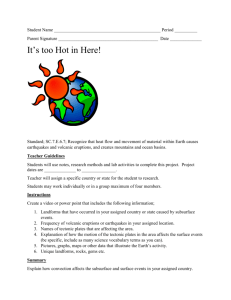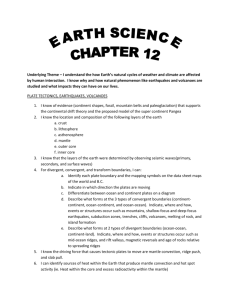Ch.3 ppt.Fill in Notes
advertisement
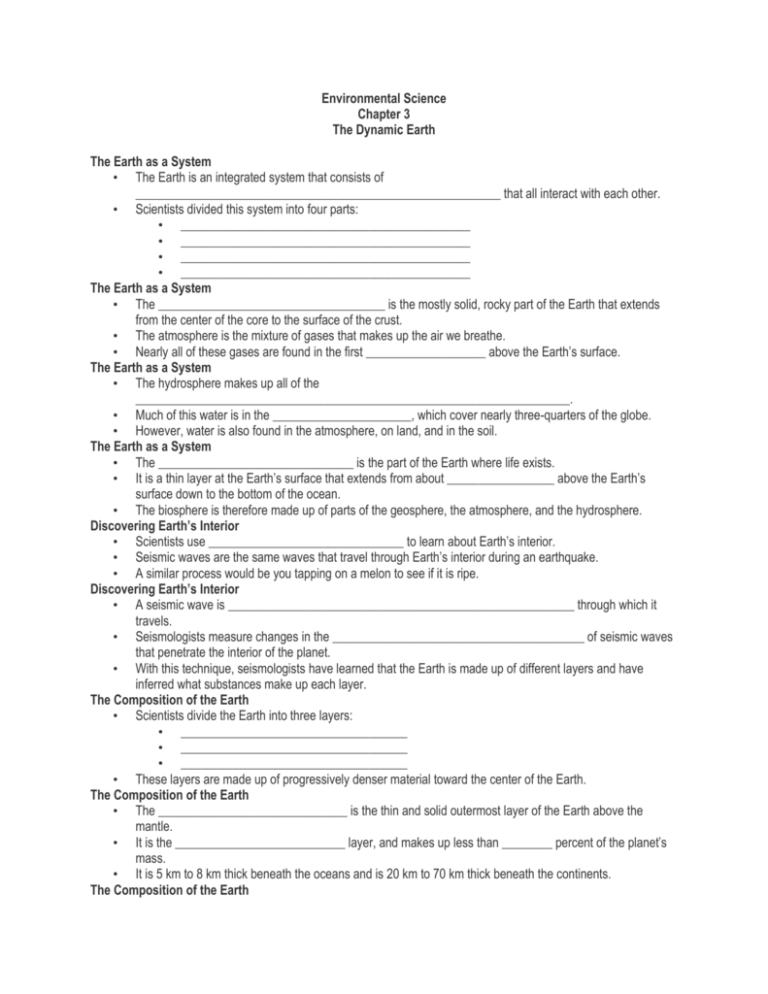
Environmental Science Chapter 3 The Dynamic Earth The Earth as a System • The Earth is an integrated system that consists of __________________________________________________________ that all interact with each other. • Scientists divided this system into four parts: • ______________________________________________ • ______________________________________________ • ______________________________________________ • ______________________________________________ The Earth as a System • The ____________________________________ is the mostly solid, rocky part of the Earth that extends from the center of the core to the surface of the crust. • The atmosphere is the mixture of gases that makes up the air we breathe. • Nearly all of these gases are found in the first ___________________ above the Earth’s surface. The Earth as a System • The hydrosphere makes up all of the _____________________________________________________________________. • Much of this water is in the ______________________, which cover nearly three-quarters of the globe. • However, water is also found in the atmosphere, on land, and in the soil. The Earth as a System • The _______________________________ is the part of the Earth where life exists. • It is a thin layer at the Earth’s surface that extends from about _________________ above the Earth’s surface down to the bottom of the ocean. • The biosphere is therefore made up of parts of the geosphere, the atmosphere, and the hydrosphere. Discovering Earth’s Interior • Scientists use _______________________________ to learn about Earth’s interior. • Seismic waves are the same waves that travel through Earth’s interior during an earthquake. • A similar process would be you tapping on a melon to see if it is ripe. Discovering Earth’s Interior • A seismic wave is _______________________________________________________ through which it travels. • Seismologists measure changes in the ________________________________________ of seismic waves that penetrate the interior of the planet. • With this technique, seismologists have learned that the Earth is made up of different layers and have inferred what substances make up each layer. The Composition of the Earth • Scientists divide the Earth into three layers: • ____________________________________ • ____________________________________ • ____________________________________ • These layers are made up of progressively denser material toward the center of the Earth. The Composition of the Earth • The ______________________________ is the thin and solid outermost layer of the Earth above the mantle. • It is the ___________________________ layer, and makes up less than ________ percent of the planet’s mass. • It is 5 km to 8 km thick beneath the oceans and is 20 km to 70 km thick beneath the continents. The Composition of the Earth The _____________________________ is the layer of rock between the Earth’s crust and core. The mantle is made of rocks of medium density, and makes up ____________ percent of the mass of the Earth. • The _____________________________ is the central part of the Earth below the mantle, and is composed of the densest elements. The Structure of the Earth • The Earth can be divided into _____________________________ layers based on the physical properties of each layer. • The __________________________________ is the solid, outer layer of the Earth that consists of the crust and the rigid upper part of the mantle. • It is a cool, rigid layer that is 15 km to 300 km thick and is divided into huge pieces called _____________________________________. The Structure of the Earth • The _________________________________ is the solid, plastic layer of the mantle beneath the lithosphere. • It is made of _____________________________________ that flows slowly, which allows tectonic plates to move on top of it. • Beneath the asthenosphere is the __________________________________, the lower part of the mantle. The Structure of the Earth • The Earth’s __________________________________ is a dense liquid layer. • At the center of the Earth is a dense, solid inner core, which is made up mostly of ______________________________________________________. • Although the temperature of the inner core is estimated to be between 4,000°C to 5,000°C, it is solid because it is under enormous pressure. • The inner and outer core make up about _____________________________ of Earth’s mass. Plate Tectonics • ____________________________________________ are blocks of lithosphere that consist of the crust and the rigid, outermost part of the mantle and glide across the underlying asthenosphere. • The continents are located on tectonic plates and move around with them. • The major tectonic plates include the Pacific, North America, South America, Africa, Eurasian, and Antarctic plates. Plate Boundaries • Much of the geological activity at the surface of the Earth takes place at the boundaries between tectonic plates. • Tectonic plates may __________________________________________ past one another. • Enormous forces are generated with these actions causing mountains to form, earthquakes to shake the crust, and volcanoes to erupt along the plate boundaries. Plate Tectonics and Mountain Building • Tectonic plates are continually moving around the Earth’s surface. • When tectonic plates collide, slip by one another, or pull apart, enormous forces cause rock to ___________________________________________. • Where plates collide, the crust becomes thicker and eventually forms mountain ranges, such as the Himalaya Mountains. Earthquakes • A ___________________________________ is a break in the Earth’s crust along which blocks of the crust slide relative to one another. • When rocks that are under stress suddenly break along a fault, a series of ground vibrations, known as ________________________________, is set off. • Earthquakes are occurring all the time. Many are so small that we cannot feel them, but some are enormous movements of the Earth’s crust that cause widespread damage. Earthquakes • • The measure of the energy released by an earthquake is called ___________________________________. • The smallest magnitude that can be felt is 2.0, and the largest magnitude ever recorded is 9.5. Magnitudes greater than 7.0 cause widespread damage. • Each increase of magnitude by one whole number indicates the release of __________________ times more energy than the whole number below it. Where do Earthquakes Occur? • The majority of earthquakes take place at or near tectonic plate boundaries because of the enormous stresses that are generated when tectonic plates separate, collide, or slip past each other. • Over the past 15 million to 20 million years, large numbers of earthquakes have occurred along the San Andreas Fault in California, where parts of the North America plate and the Pacific plate are slipping past one another. Earthquake Hazard • Scientists cannot predict when earthquakes will take place. However, they can help provide information about where earthquakes are likely to occur helping people prepare. • An area’s ________________________________________________ is determined by past and present seismic activity. • Earthquake-resistant buildings, built in high-risk areas, are slightly flexible so that they can sway with the ground motion preventing them from collapsing. Volcanoes • A _______________________________ is a mountain built from magma, or melted rock, which rises from the Earth’s interior to the surface, and can occur on land or in the sea. • Volcanoes are often located near tectonic plate boundaries where plates are either colliding or separating from one another. • The majority of the world’s active volcanoes on land are located along tectonic plate boundaries that surround the ______________________________________. • Local Effect of Volcanic Eruptions • Clouds of host ash, dust, and gases can flow down the slope of a volcano at speeds of up to ________________________________ and sear everything in their path. • During an eruption, volcanic ash can mix with water and produce mudflow that runs downhill. • In addition, ash that falls to the ground can cause buildings to collapse under its weight, bury crops, damage the engines of vehicles, and cause breathing difficulties. Global Effects of Volcanic Eruptions • Major volcanic eruptions can change Earth’s climate for several years. • In large eruptions, clouds of volcanic ash and sulfur rich gases may reach the upper atmosphere, and spread across the planet ____________________________________________________________ that reaches the Earth’s surface. • The reduction in sunlight can cause a drop in the ____________________________________________________________.
